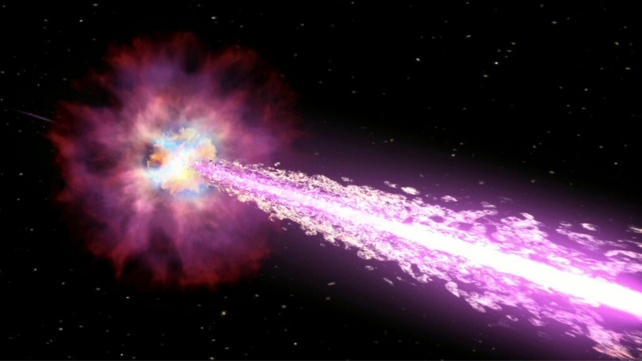If you’re a supervillain genius looking to shock your enemy with a big messy space kablooie, here’s a new way to do it. Combine the two ancient star remnants right in front of your enemy.
The result will give you a massive, bright explosion and a bonus gamma-ray burst visible throughout the Universe. And, it will scare everyone into doing your bad bidding.
Of course, in order to do this, you need to have a very strange power. Those don’t exist outside the realm of comics. But, in the real universe, there ARE ways to do it. You just need massive stellar objects that are clustered together in space. Then, they get a little close, and – blame! A massive explosion visible for billions of light-years.
GRB 191019A: the Star Destroyer
On 19 October 2019, astronomers pointed to the origin of such an event, called GRB 191019A. The first indication was a long-duration gamma-ray burst (GRB) that lasted about a minute. (That’s long in GRB terms, although there is evidence that some last longer. However, most are only a few seconds to a few microseconds long.) The Neil Gehrels Swift Observatory detected it immediately.

Astronomers spent months after looking at the fading sunset of the GRB’s source. They used the International Gemini Observatory, along with the Nordic Optical Telescope, and the Hubble Space Telescope. Observations have revealed the stellar death scene in the crowded heart of a galaxy 3 billion light-years away.
Observers described it as an almost demolition derby-like collision of stellar remnants and stars in the turbulent region of the galaxy’s central supermassive black hole. The source of the GRB flash is only 100 light-years away from the heart of the galaxy. It became close to the central supermassive black hole.
“These new results show that stars can meet their demise in some of the densest regions of the Universe where they can be driven into collisions,” said Andrew Levan, lead author of a paper about on the GRB and its origin.
“This is exciting for understanding how stars die and for answering other questions, such as what unexpected sources can create the gravitational waves we can see on Earth. “
Finding Star Destroyers in Unusual Locations
What’s unusual about this event is that it occurred in a very old galaxy, according to Levan.
“Our follow-up observations told us that rather than being a massive star collapsing, the explosion was likely caused by the merger of two compact objects,” Levan said.
“By pinpointing its location at the center of a previously identified ancient galaxy, we have the first tantalizing evidence of a new pathway for stars to meet their demise.”
An aging galaxy isn’t necessarily where you’d expect to find massive fireworks. That’s because it’s long past its prime star-forming time. Most giant stars have died as supernovae. However, its core could be an ideal place for the destruction of stellar debris in collisions.
frameborder=”0″ allow=”accelerometer; auto-play; clipboard-write; encrypted media; gyroscope; picture-in-picture; web-share” allowfullscreen>
The central regions of many ancient galaxies host large populations of stars. By some estimates, over a million people are heading for a region just a few light-years across. There are also clouds of gas and dust, along with a population of stellar remnants – the black holes and neutron stars from the deaths of massive stars.
All of these objects orbit the central supermassive black hole. It doesn’t take much to merge two stellar objects (whether they’re nearby or debris) under the gravitational influence of the central black hole.
One second two objects revolve around each other; next they collide and produce a large burst that we see as a long-lived GRB. There is also a burst of gravitational waves, followed by a flash of light.
Looking for More GRBs
Astronomers have yet to see many of these long collision GRBs in normal galaxies, but they probably happen more often than anyone realizes. The galactic cores where they occur are often obscured by clouds of gas and dust, obscuring the GRB’s initial flash and subsequent sunset. Fortunately, GRB 191019A happened more or less “in the clear”, which gave observers the opportunity to watch it for a long time.
GRB 191019A is the first observed event involving stellar debris in a dense atmosphere at the galactic core. Levan and the others want to find more of them, now that they know what to look for. Their hope is to match a GRB detection with a corresponding gravitational-wave detection, which will reveal more about their true nature and confirm their origins, even in the smallest atmosphere.
Fortunately existing observatories can play a role, along with upcoming facilities such as the Vera C. Rubin Observatory.
“The study of gamma-ray bursts like this is a good example of how the field is really progressing with many facilities working together, from GRB detection to the detection of afterglows and distances using telescopes like Gemini, to the detailed separation of events with observations across the electromagnetic spectrum,” said Levan.
This article was originally published by Universe Today. Read the original article.
#Astronomers #Discover #Strange #Destroying #Stars














Add Comment